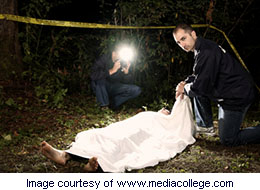Forensic Photography

While most forms of photography are enjoyed simply for fun, forensic photography is serious business. Also known as crime scene photography and forensic imaging, forensic photography is used to document crime scenes and help police and investigators bring those responsible to justice.
These crime scene photographs are often used in the courtroom to give the jury a true picture of what happened, as well as to document and preserve evidence. The job of the forensic photographer is to accurately reproduce the accident or crime scene so that the evidence can be preserved and eventually used in a court of law. Forensic photography can mean everything from photographing a dead body where it fell to taking pictures of a crumpled front bumper from an accident scene.
In order to accurately document a crime scene, accident scene or other event, forensic photographers need to focus on things like choosing the proper lighting and using the right lenses and angles to accurately represent what happened. In addition, it is important for forensic photographers to shoot from a variety of different viewpoints in order to provide more complete information.
Forensic photographers also often use scales in their photographs. These scales provide important information about the relative size and position of various objects in the photo, and that information can be particularly useful in courtroom situations.
While most forensic photography is in color, black and white photographs are occasionally called for as well. Forensic photographers around the country and around the world also use a mixture of traditional 35mm and digital photography, depending on the mandates and policies of each individual police force and government agency. When digital photography is allowed, it is important for the cameras to have a very high resolution. These high resolutions will allow the resulting images to be resized and expanded to allow police investigators to accurately assess and examine all the objects in the image. The details in forensic photographs can make a big difference in court, and it is essential that the photographic equipment used allow for the necessary enlargement and manipulation.
Even though forensic photography has been around nearly as long as the photograph itself, the field continues to grow and change. Forensic photographers and the police forces they support are using all sorts of images in their work, including still images and videos from camera phones, traffic cameras and other sources. Skillful police investigators and forensic personnel must often piece together images from a variety of sources, including traditional crime scene photographs, images taken by passersby and video pulled from static surveillance cameras, in order to provide a true picture of what really happened. Providing the investigators, the witnesses, the victims and ultimately the jury with a true picture of the crime scene as it was is the job of the forensic photographer, and it is truly a vital job in today’s dangerous world.